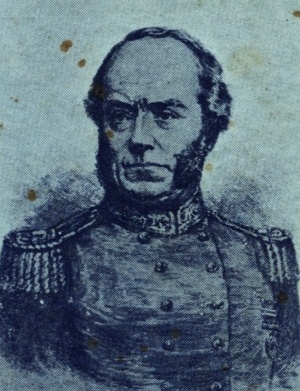 Major Mitchell
Major MitchellExtract from the Diary of
MAJOR MITCHELL
August, 1836
"At length I approached a ravine on the left, which at first I took for that of the river; but I soon perceived through the trees on the right, a still greater opening; and thus I at last found the valley of the Glenelg. In the ravine to the left ran another small stream. This was the Crawford. We reached the bank of this at 2¾ miles from the place where we left the party, and at about half a mile above its junction with the main stream. The high ground between the two streams terminated in a round grassy promontory, overlooking one of the finest flats imaginable. I determined to endeavour once more to explore the river's course with the boats, provided we should succeed in transporting them over the mud to this spot.
"Next day, fortunately, by skirting the head of a ravine, firm ground was found, with only one bad place intervening. On 17th August, after persistent labour in the mud and mire, the whole party reached the camping place. Piper, the native guide, reconoitring the river, reported streams in on the left, one large one from the right, falling on the rocks, and the Glenelg itself large, like the Murray, and good for boats.
"All this news only made me more impatient to embark in them. The barometer was rising, the spring was advancing, and the approaching warmth might be expected to harden the ground. The cattle would be refreshed by a week's rest in the midst of the rich pasture around us, while our labours, to all appearance, were on the eve of being crowned by the discovery of some harbour which might serve as a port to one of the finest regions upon earth.
"August 18th - The boats were hoisted out to be launched once more on the bosom of the Glenelg, and they were loaded with what the party going with them might require for ten days. I left with Mr. Stapleton instructions, that the men under his charge should move up to, and occupy the round point of the hill, a position which I named Fort O'Hare, in memory of a truly brave soldier, my Commanding Officer, who fell at Badajoz in leading the forlorn hope of the Light Division to the Storm. At twelve o'clock I embarked on the river with sixteen men in two boats, leaving eight with Mr. Stapleton in the depot.
"We had no difficulty in going down the picturesque river with its limestone cliffs, timbered and festooned. The course changed to the west. Aquatic birds were numerous-ducks, pelicans, and swans. On the second day, the water was slightly brackish, the river increased in breadth to 101 yards, and in depth to five fathoms. It was, upon the whole, considering the permanent fulness of the stream, the character of its banks, and uniformity of width and depth, the finest body of fresh water I had seen in Australia. In the morning there was a tidal rise of 6 feet, a change of direction to the south-east, and banks diminished in size. A small bushy island was passed, called Isle of Bags, and we soon came to the entrance, not open as expected, but choked by a sand-bar. Named the inlet Discovery Bay. On re-entering the river from the open sea, I presented the men with a bottle of whisky with which it was formally named the Glenelg.
"The return to Fort O'Hare was effected without hindrance, the arrival being made at 2 p.m., Aug. 22nd, where all was well. During the afternoon I laid down the survey of the estuary of the Glenelg, and completed by 10 p.m. not only my plan of it, but that of the river also. Mr. Stapleton had set Vulcan to repair the broken chains, etc.-a ford had been cleared across the stream, from the north-east, which I named the Crawford; and the cattle being refreshed, we were once more in trim to continue the land journey."
Source: "Dartmoor and District Centenary Celebrations, Dartmoor, December 18, 19 & 20 1936 - Souvenir Program, Price: One Shilling"